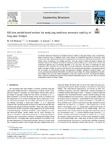Mostrar o rexistro simple do ítem
Efficient Modal-Based Method for Analyzing Nonlinear Aerostatic Stability of Long-Span Bridges
| dc.contributor.author | Cid Montoya, Miguel | |
| dc.contributor.author | Hernández, Santiago | |
| dc.contributor.author | Kareem, Ahsan | |
| dc.contributor.author | Nieto Mouronte, Félix | |
| dc.date.accessioned | 2021-08-25T08:38:35Z | |
| dc.date.available | 2021-08-25T08:38:35Z | |
| dc.date.issued | 2021 | |
| dc.identifier.citation | Cid Montoya, M., Hernández, S., Kareem, A., Nieto, F. (2021). Efficient modal-based method for analyzing nonlinear aerostatic stability of long-span bridges. Engineering Structures, 244, 112556. https://doi.org/10.1016/j.engstruct.2021.112556 | es_ES |
| dc.identifier.uri | http://hdl.handle.net/2183/28324 | |
| dc.description | Financiado para publicación en acceso aberto: Universidade da Coruña/CISUG | es_ES |
| dc.description.abstract | [Abstract] An efficient method for analyzing the nonlinear aerostatic stability of long-span bridges using a modal formulation is proposed. First, a simplified linear version defined as modal-based approach is introduced, which evaluates the bridge displacements using the modal properties of the bridge and speeds up the assessment of the critical velocity by applying a root-finding algorithm. Then, this scheme is further developed to identify the instability limit point in nonlinear structures by combining nonlinear FEM analyses with the linear version of the modal-based approach and a root-finding algorithm in an outer loop. The effects of considering the three components of the wind loads, the stays sag effect, structural nonlinearities, aerodynamic nonlinearities, and the initial wind angle of attack, are analyzed and discussed. The computational advantages of the proposed method and its accuracy are demonstrated through three application examples, including a simplified linear 1 DoF system, and linear and nonlinear FEM models of a full cable-stayed bridge. The collapse mechanism of the cable-stayed bridge is driven by the stiffness degradation of the stays caused by the deck vertical upward displacements. It has been found that the influence of the nonlinear aerodynamic features is very low when the structural nonlinearities control the bridge collapse. | es_ES |
| dc.description.sponsorship | Xunta de Galicia; ED481B2018/053 | es_ES |
| dc.description.sponsorship | Xunta de Galicia; ED431C 2017/72 | es_ES |
| dc.description.sponsorship | EEUU. National Science Foundation; CMMI #1562244 | es_ES |
| dc.description.sponsorship | M. Cid Montoya is funded by the Xunta de Galicia (Galician regional government) and the Fulbright Scholar Program with reference ED481B2018/053. S. Hernández, F. Nieto, and M. Cid Montoya have been funded by the Spanish Ministry of Economy and Competitiveness in the frame of the research project with reference PID2019-110786 GB-I00, and the Xunta de Galicia, including FEDER funding, with reference ED431C 2017/72. A. Kareem especially thanks NSF for in part support under grant CMMI #1562244. | es_ES |
| dc.language.iso | eng | es_ES |
| dc.publisher | Elsevier | es_ES |
| dc.relation | info:eu-repo/grantAgreement/AEI/Plan Estatal de Investigación Científica y Técnica y de Innovación 2017-2020/PID2019-110786GB-I00/ES/ | |
| dc.relation.uri | https://doi.org/10.1016/j.engstruct.2021.112556 | es_ES |
| dc.rights | Atribución 4.0 Internacional (CC BY 4.0) | es_ES |
| dc.rights.uri | https://creativecommons.org/licenses/by/4.0/ | * |
| dc.subject | Aerostatic stability | es_ES |
| dc.subject | Critical wind velocity | es_ES |
| dc.subject | Dynamic analysis | es_ES |
| dc.subject | Cable-stayed bridges | es_ES |
| dc.subject | Nonlinear analysis | es_ES |
| dc.subject | Cable sagging | es_ES |
| dc.subject | Root-finding algorithms | es_ES |
| dc.subject | FEM | es_ES |
| dc.title | Efficient Modal-Based Method for Analyzing Nonlinear Aerostatic Stability of Long-Span Bridges | es_ES |
| dc.type | info:eu-repo/semantics/article | es_ES |
| dc.rights.access | info:eu-repo/semantics/openAccess | es_ES |
| UDC.journalTitle | Engineering Structures | es_ES |
| UDC.volume | 244 | es_ES |
| UDC.startPage | 112556 | es_ES |
| dc.identifier.doi | 10.1016/j.engstruct.2021.112556 |
Ficheiros no ítem
Este ítem aparece na(s) seguinte(s) colección(s)
-
CITEEC-ME - Artigos [22]






